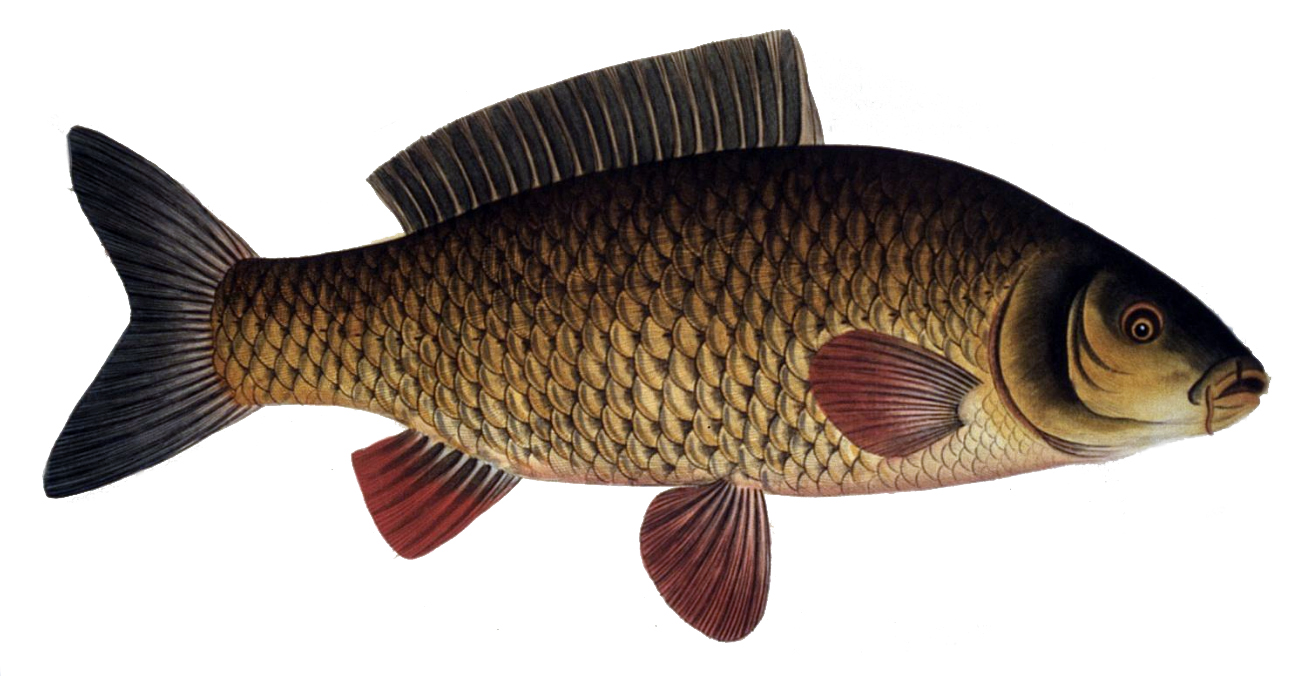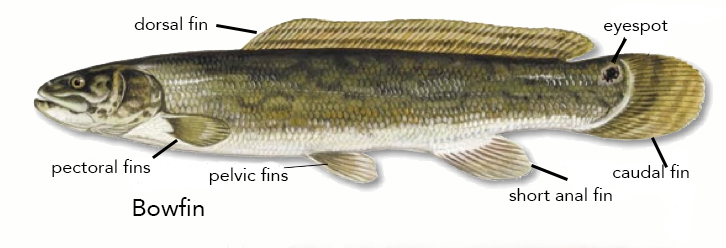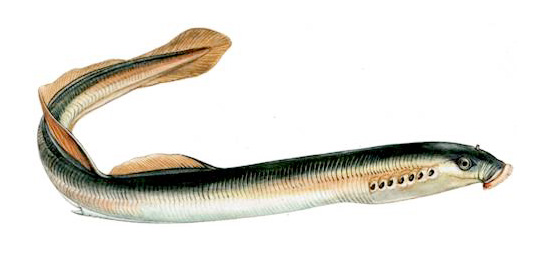|
Halecomorphi
Halecomorphi is a taxon of Actinopterygii, ray-finned bony fish in the clade Neopterygii. The only extant Halecomorph species are the bowfin (''Amia calva'') and eyespot bowfin (''Amia ocellicauda''), but the group contains many extinct species in several family (biology), families (including Amiidae, Caturidae, Liodesmidae, Sinamiidae) in the order (biology), order Amiiformes, as well as the extinct orders Ionoscopiformes, Panxianichthyiformes, and Parasemionotiformes. The fossil record of halecomorphs goes back at least to the Early Triassic epoch (geology), epoch. The Halecomorphi exhibit a combination of plesiomorphy, ancestral features, such as most heavily mineralized fish scale, scales, but also by more derived or "modern" features, particularly in the structure of the skull (e.g. position and shape of preopercles). Unique derived traits (synapomorphies) of the Halecomorphi include: *Unique jaw articulation in which the Quadrate bone, quadrate and Symplectic bone, sy ... [...More Info...] [...Related Items...] OR: [Wikipedia] [Google] [Baidu] |
Caturidae
Caturidae is an extinct Family (biology), family of predatory Amiiformes, amiiform Actinopterygii, ray-finned fish, being the sister-group to the extant family Amiidae. Though their body form is very different than the modern bowfin, a number of features in the skull point towards a close relationship between the groups. Members of the family were generally larger fish that lived within more coastal marine environments along with freshwater environments near the coast. In these environments, caturids would have fed on a variety of prey items, hunting them similarly to fish like Gar, gars and Barracuda, barracudas. The earliest members of the family appeared in the early Late Triassic, reaching an apex of diversity during the Jurassic with the youngest records of the group date to the Early Cretaceous. History Caturidae was erected by Owen in 1860 though members of the family have been known since the early 19th century, with genera like ''Caturus'' being described before the fami ... [...More Info...] [...Related Items...] OR: [Wikipedia] [Google] [Baidu] |
Amiiformes
The Amiiformes order (biology), order of fish has only two extant taxa, extant species, the bowfins: ''Amia calva'' and ''Amia ocellicauda'', the latter recognized as a separate species in 2022. These Amiiformes are found in the freshwater systems of North America, in the United States and parts of southern Canada. They live in freshwater streams, rivers, and swamps. The order first appeared in the Triassic, and the extinct members include both marine and freshwater species, many of which are morphologically disparate from bowfins, such as the Caturidae, caturids. Evolution and diversity The extinct species of the Amiiformes can be found as fossils in Asia and Europe, but the bowfin is the last living species in the order. Amiiformes is therefore the last surviving order (biology), order of Halecomorphi, the clade to which the bowfin and its fossil relatives belong. Other orders, such as the Parasemionotiformes, are all extinct. Halecomorphs, and its sister group Ginglymodi, be ... [...More Info...] [...Related Items...] OR: [Wikipedia] [Google] [Baidu] |
Parasemionotiformes
Parasemionotiformes is an extinct order of neopterygian ray-finned fish that existed globally during the Triassic period. It comprises the families Parasemionotidae and Promecosominidae. Many of the included genera are monotypic and most species lived during the Early Triassic epoch. Parasemionotiforms were normally small to medium-sized fishes. They were predominantly marine. Evolutionary relationships Parasemionotiformes are neopterygians, which is the clade that encompasses the vast majority of living ray-finned fishes (Actinopterygii) and about half of all living species of vertebrates. Neopterygii are divided into Teleostei and Holostei. The latter represents a depauperate group today but used to be a diverse clade especially during the Mesozoic Era. The only surviving members of the Holostei are the gars ( Ginglymodi) and the bowfin (Halecomorphi). Parasemionotiformes belong to Holostei and are one of the earliest clades of the Halecomorphi (bowfin and its extinct rela ... [...More Info...] [...Related Items...] OR: [Wikipedia] [Google] [Baidu] |
Cipactlichthys Scutatus
''Cipactlichthys'' is a genus of extinct marine holostean fish from the Lower Cretaceous of Mexico, distantly related to modern bowfins. The only known species is ''Cipactlichthys scutatus''. Discovery and etymology ''Cipactlichthys scutatus'' is known from two fossils discovered in the Tlayua Formation near the town of Tepexi de Rodríguez, in Puebla, Mexico. The Tlayua Formation, is Albian (Early Cretaceous) in age, interpreted as an epicontinental marine deposit. Due to its high quality preservation and abundance of fish fossils, the formation is considered one of the most important sources of Cretaceous fishes in Mexico. The genus name is a combination of ''Cipactli'', the Aztec mythological sea monster said to be part fish and part reptile, and ''ichthys'', Greek for "fish". The specific epithet ''scutatus'' is Latin for shielded, referring to the large dorsal and ventral scutes. Description ''Cipactlichthys'' is an elongate fish, approximately 130 mm in tota ... [...More Info...] [...Related Items...] OR: [Wikipedia] [Google] [Baidu] |
Bowfin
The ruddy bowfin (''Amia calva'') is a ray-finned fish native to North America. Common names include mudfish, mud pike, dogfish, grindle, grinnel, swamp trout, and choupique. It is regarded as a relict, being one of only two surviving species of the Halecomorphi, a group of fish that first appeared during the Early Triassic, around 250 million years ago. The bowfin is often considered a "living fossil" because they have retained some morphological characteristics of their early ancestors. It is one of two species in the genus ''Amia,'' along with '' Amia ocellicauda'', the eyespot bowfin. The closest living relatives of bowfins are gars, with the two groups being united in the clade Holostei. Bowfins are demersal freshwater piscivores, commonly found throughout much of the eastern United States, and in southern Ontario and Quebec. Fossil deposits indicate Amiiformes were once widespread in both freshwater and marine environments across North and South America, Europe, ... [...More Info...] [...Related Items...] OR: [Wikipedia] [Google] [Baidu] |
Neopterygii
Neopterygii (from Greek νέος ''neos'' 'new' and πτέρυξ ''pteryx'' 'fin') is a subclass of ray-finned fish (Actinopterygii). Neopterygii includes the Holostei and the Teleostei, of which the latter comprise the vast majority of extant fishes, and over half of all living vertebrate species. While living holosteans include only freshwater taxa, teleosts are diverse in both freshwater and marine environments. Many new species of teleosts are scientifically described each year. The potentially oldest known neopterygian is the putative " semionotiform" '' Acentrophorus varians'' from the Middle Permian of Russia; however, one study incorporating morphological data from fossils and molecular data from nuclear and mitochondrial DNA, places this divergence date at least 284 mya (million years ago), during the Artinskian stage of the Early Permian. Another study suggests an even earlier split (360 myr ago, near the Devonian-Carboniferous boundary). Evolution a ... [...More Info...] [...Related Items...] OR: [Wikipedia] [Google] [Baidu] |
Sinamiidae
Sinamiidae is an extinct family of ray-finned fish. They are halecomorph fishes endemic to Early Cretaceous freshwater environments in East and Southeast Asia. Along with Amiidae, it is one of two families that makes up the superfamily Amioidea. The two are distinguished by the shape of their scales. Some authors treat them as a subfamily, the Sinamiinae, within the Amiidae as the closest relatives of the modern subfamily Amiinae. References † A dagger, obelisk, or obelus is a typographical mark that usually indicates a footnote if an asterisk has already been used. The symbol is also used to indicate death (of people) or extinction (of species or languages). It is one of the mo ... Prehistoric ray-finned fish families Cretaceous bony fish Early Cretaceous fish of Asia {{Amiiformes-stub ... [...More Info...] [...Related Items...] OR: [Wikipedia] [Google] [Baidu] |
Bony Fish
Osteichthyes ( ; ), also known as osteichthyans or commonly referred to as the bony fish, is a Biodiversity, diverse clade of vertebrate animals that have endoskeletons primarily composed of bone tissue. They can be contrasted with the Chondrichthyes (cartilaginous fish) and the extinct placoderms and acanthodians, which have endoskeletons primarily composed of cartilage. The vast majority of extant taxon, extant fish are members of Osteichthyes, being an extremely diverse and abundant group consisting of 45 order (biology), orders, over 435 family (biology), families and 28,000 species. The group is divided into two main clades, the ray-finned fish (Actinopterygii, which makes up the vast majority of extant fish) and the lobe-finned fish (Sarcopterygii, which gave rise to all land vertebrates, i.e. tetrapods). The oldest known fossils of bony fish are about 425 million years old from the late Silurian, which are also transitional fossils showing a dentition, tooth pattern th ... [...More Info...] [...Related Items...] OR: [Wikipedia] [Google] [Baidu] |
Amiidae
The Amiidae are a family of basal ray-finned fishes. The bowfin and the eyespot bowfin ('' Amia ocellicauda'') are the only two species to survive today, although additional species in all four subfamilies of Amiidae are known from Jurassic, Cretaceous, and Eocene fossils. Bowfins are now found throughout eastern North America, typically in slow-moving backwaters, canals, and ox-bow lakes. When the oxygen level is low (as often happens in still waters), the bowfin can rise to the surface and gulp air into its swim bladder, which is lined with blood vessels and can serve as a primitive lung. Amiidae is a monophyletic group that has numerous synapomorphic characters. Amiidae were widespread and particularly rich in species during the Eocene era. During this era, they appeared to be confined almost exclusively to fresh water. Taxonomy The family is divided into five subfamilies, with 16 genera *Amiidae **Subfamily Amiinae (latest Cretaceous -Present) ***Genus '' Amia'' ***Genus ... [...More Info...] [...Related Items...] OR: [Wikipedia] [Google] [Baidu] |
Liodesmidae
''Liodesmus'' is an extinct genus of ray-finned fish that lived during the early Toarcian stage of the Early Jurassic The Early Jurassic Epoch (geology), Epoch (in chronostratigraphy corresponding to the Lower Jurassic series (stratigraphy), Series) is the earliest of three epochs of the Jurassic Period. The Early Jurassic starts immediately after the Triassic� ... epoch. References Caturoidea Early Jurassic fish {{jurassic-fish-stub ... [...More Info...] [...Related Items...] OR: [Wikipedia] [Google] [Baidu] |
Actinopterygii
Actinopterygii (; ), members of which are known as ray-finned fish or actinopterygians, is a class (biology), class of Osteichthyes, bony fish that comprise over 50% of living vertebrate species. They are so called because of their lightly built fish fin, fins made of webbings of skin supported by radially extended thin bony spine (zoology), spines called ''lepidotrichia'', as opposed to the bulkier, fleshy lobed fins of the sister taxon, sister clade Sarcopterygii (lobe-finned fish). Resembling folding fans, the actinopterygian fins can easily change shape and wetted area, providing superior thrust-to-weight ratios per movement compared to sarcopterygian and chondrichthyian fins. The fin rays attach directly to the proximal or basal skeletal elements, the radials, which represent the articulation (anatomy), articulation between these fins and the internal skeleton (e.g., pelvic and pectoral girdles). The vast majority of actinopterygians are teleosts. By species count, they domi ... [...More Info...] [...Related Items...] OR: [Wikipedia] [Google] [Baidu] |








